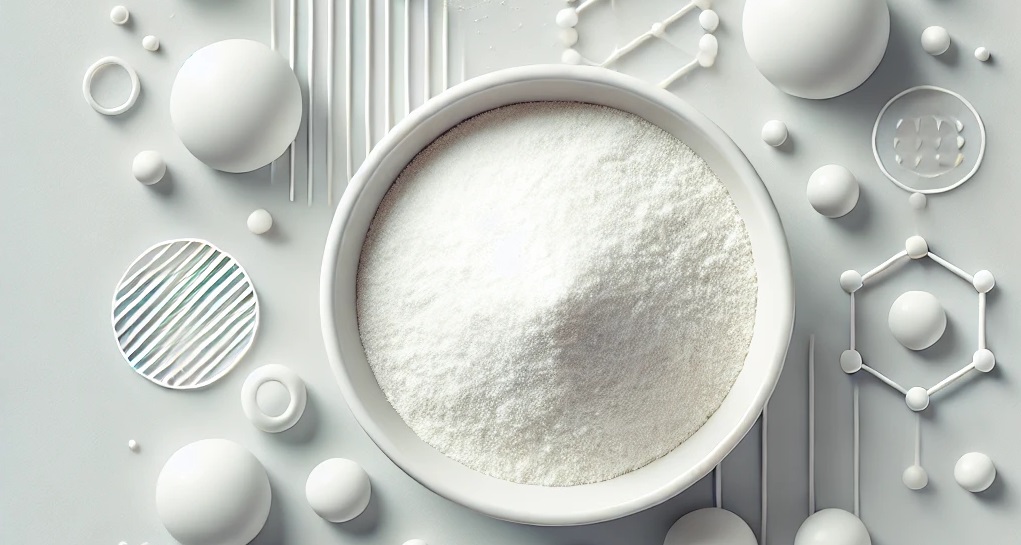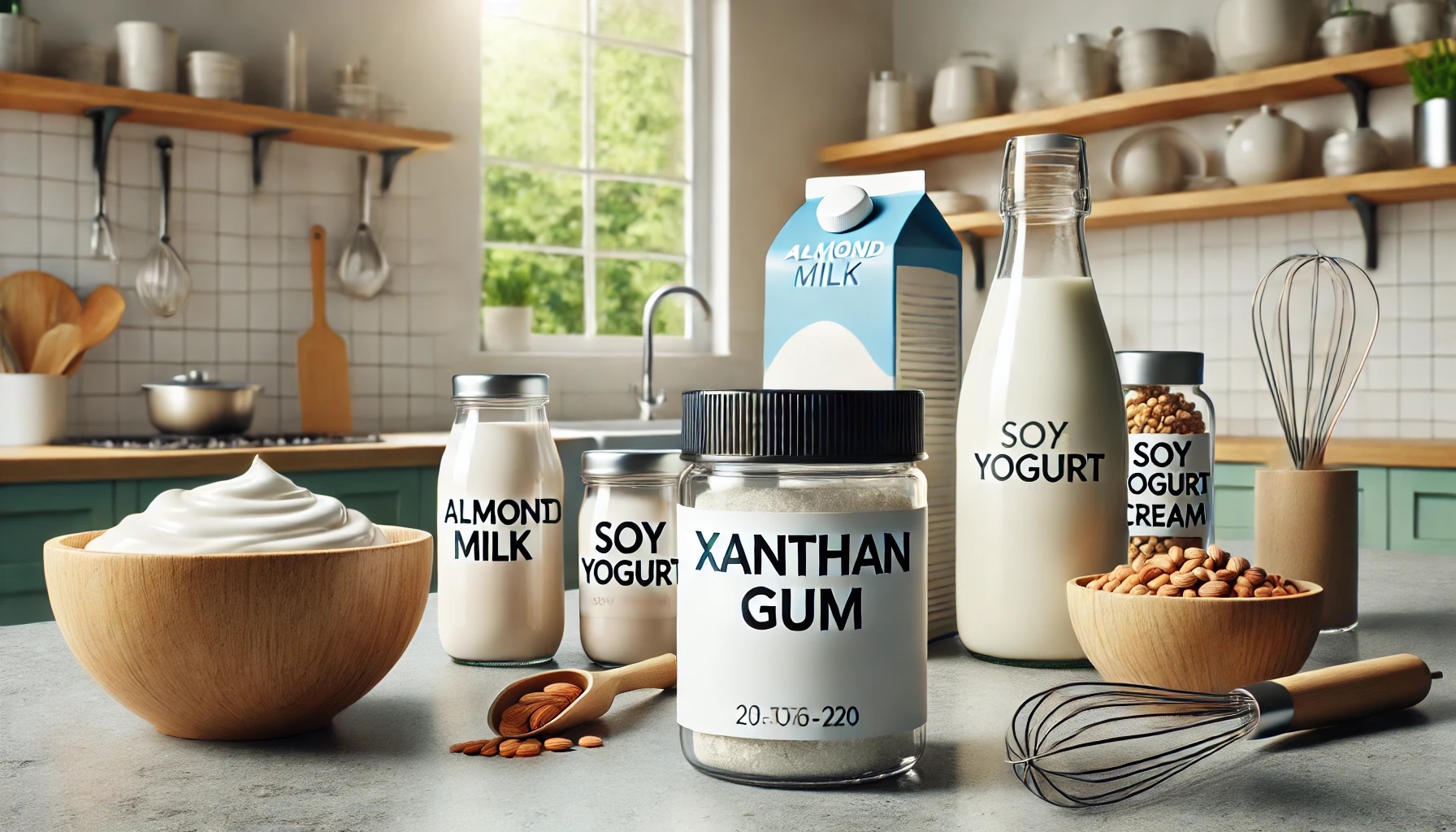1. What is xanthan gum?
It is a polysaccharide used as a food additive and rheology modifier.
It is produced through the fermentation of glucose or sucrose by the Xanthomonas campestris bacterium.
Known for its thickening, stabilizing, and emulsifying properties, it is widely used in food and beverage products to improve texture and consistency.
2. How is xanthan gum produced?
It is produced by fermenting a carbohydrate source (like corn sugar) with the bacterium Xanthomonas campestris.
The resulting polysaccharide is then precipitated, purified, dried, and ground into a fine powder. This process ensures a high-purity product suitable for various applications.
3. What are the main applications of xanthan gum in the food industry?
It is used as a thickener, stabilizer, and emulsifier in a wide range of products, including salad dressings, sauces, dairy products, beverages, and gluten-free baked goods.
It helps to improve texture, consistency, and shelf stability by preventing ingredient separation and maintaining viscosity.
4. How does xanthan gum affect the texture of food products?
It enhances the texture of food products by increasing viscosity and creating a smooth, creamy mouthfeel.
It prevents separation and maintains uniformity in products like dressings and sauces.
In baked goods, it improves crumb structure and moisture retention, especially in gluten-free recipes.
5. Is xanthan gum safe for consumption?
Yes, It is considered safe for consumption by major regulatory agencies, including the FDA, EFSA, and WHO. It is approved for use in various food products and is generally recognized as safe (GRAS). It is non-toxic and has been extensively studied for safety.
6. How does xanthan gum interact with other ingredients?
It interacts synergistically with other hydrocolloids like guar gum and locust bean gum to enhance viscosity and gel strength.
It is compatible with a wide range of ingredients, including proteins, sugars, and salts, making it versatile for various formulations.
7. What are the functional properties of xanthan gum?
It exhibits excellent thickening, stabilizing, and emulsifying properties.
It is highly stable under a range of pH levels and temperatures, making it suitable for hot and cold applications.
It also provides consistent viscosity, preventing ingredient separation in food products.
8. Can xanthan gum be used in gluten-free baking?
Yes, It is widely used in gluten-free baking to mimic the structure and elasticity provided by gluten.
It helps to improve the texture, moisture retention, and shelf life of gluten-free baked goods, resulting in a product that is closer to traditional baked goods in quality.
9. How does xanthan gum impact the viscosity of liquids?
It significantly increases the viscosity of liquids even at low concentrations.
It provides a stable and consistent thickening effect, which is valuable in products like sauces, dressings, and beverages. Its ability to maintain viscosity under various conditions makes it ideal for many applications.
10. What are the recommended usage levels of xanthan gum in different food products?
The recommended usage levels vary depending on the application.
Generally, it ranges from 0.05% to 0.5% by weight in most food products.
For example, 0.1% to 0.2% is typical in salad dressings, while up to 0.5% may be used in gluten-free baking.
11. How does xanthan gum affect the stability of emulsions?
It enhances the stability of emulsions by increasing the viscosity of the continuous phase, which helps to suspend and stabilize dispersed droplets.
This prevents separation and improves the shelf life and consistency of products like salad dressings and sauces.
12. Is xanthan gum suitable for use in dairy products?
Yes, It is suitable for use in dairy products such as yogurt, ice cream, and cheese.
It improves texture, viscosity, and stability, preventing whey separation in yogurt and ice crystal formation in ice cream, resulting in a creamier and smoother product.
13. Can xanthan gum be used in beverages?
Yes, It is used in beverages to enhance mouthfeel, stabilize suspensions, and prevent ingredient separation.
It is particularly useful in fruit juices, flavored water, and nutritional drinks, where it helps to maintain a uniform consistency and improve the sensory experience.
14. How does temperature affect the performance of xanthan gum?
It is stable across a wide range of temperatures.
It maintains its thickening and stabilizing properties in both hot and cold applications.
Its viscosity remains consistent even when subjected to heat treatments, making it ideal for products that undergo thermal processing.
15. What are the common sources of carbohydrates used to produce xanthan gum?
Common sources of carbohydrates used to produce It include glucose, sucrose, and lactose.
These carbohydrates are fermented by the Xanthomonas campestris bacterium to produce It.
Corn sugar is a particularly common source due to its availability and cost-effectiveness.
16. How does pH affect the functionality of xanthan gum?
It is stable across a wide range of pH levels, typically from 2 to 12.
This stability allows it to maintain its thickening and stabilizing properties in acidic and alkaline environments, making it suitable for various food products, including acidic dressings and beverages.
17. Can xanthan gum be used in frozen foods?
Yes, It is used in frozen foods to improve texture and stability.
It helps prevent ice crystal formation in products like ice cream and frozen desserts, ensuring a smooth and creamy texture.
It also enhances the freeze-thaw stability of other frozen foods.
18. How is xanthan gum labeled on food packaging?
It is labeled as “xanthan gum” on food packaging. It is often listed under the ingredients section.
In some cases, it may also be identified by its E number, E415, particularly on products sold in the European Union.
19. What are the sensory characteristics of xanthan gum?
It is generally neutral in taste and odor, making it suitable for a wide range of food applications without affecting the sensory properties of the final product.
Its main contribution is to texture, where it provides a smooth and uniform mouthfeel.
20. How does xanthan gum affect the shelf life of food products?
It enhances the shelf life of food products by improving stability and preventing separation.
Its thickening and stabilizing properties help maintain the desired texture and consistency over time, reducing the likelihood of spoilage and ensuring a longer-lasting product.
21. Can xanthan gum be used in low-fat or reduced-calorie products?
Yes, It is commonly used in low-fat and reduced-calorie products to improve texture and mouthfeel that might otherwise be lost with the reduction of fat content.
It provides a creamy and smooth texture, enhancing the sensory qualities of these products.
22. How does xanthan gum compare to other hydrocolloids?
It is known for its excellent stability under various conditions, including pH, temperature, and shear.
Compared to other hydrocolloids like guar gum or locust bean gum, xanthan gum often provides better viscosity control and consistency.
It is also more effective at lower concentrations.
23. What are the potential allergens in xanthan gum?
It is not a common allergen.
However, it can be produced from carbohydrate sources like corn, soy, or wheat, which could potentially cause allergic reactions in sensitive individuals.
It is important to check the source of the carbohydrate used in production.
24. How does xanthan gum behave under shear stress?
It exhibits shear-thinning properties, meaning its viscosity decreases under shear stress (such as stirring or mixing) and returns to its original viscosity when the stress is removed.
This behavior makes it ideal for products that need to be pourable yet stable.
25. Can xanthan gum be used in meat products?
Yes, It can be used in meat products to enhance texture, moisture retention, and stability.
It helps improve the juiciness and mouthfeel of processed meats, sausages, and meat analogs. It also aids in binding ingredients together, ensuring a uniform product.
26. What is the environmental impact of xanthan gum production?
The production involves fermentation, which can have environmental impacts related to energy use, water consumption, and waste generation.
However, efforts are being made to improve the sustainability of the production process through better resource management and waste treatment practices.
27. How does xanthan gum perform in frozen desserts?
It performs well in frozen desserts by preventing ice crystal formation and improving texture.
It helps create a smooth and creamy consistency, enhancing the overall sensory experience. Its stability under freeze-thaw conditions ensures the quality of the dessert is maintained.
28. Can xanthan gum be used in confectionery products?
Yes, It is used in confectionery products to improve texture, prevent sugar crystallization, and enhance shelf stability.
It helps create a smooth and uniform consistency in items like gummy candies, jelly beans, and other chewy or gel-like sweets.
29. What are the sensory characteristics of xanthan gum?
It is neutral in taste and odor, making it suitable for various food applications without impacting the sensory properties of the final product.
Its main contribution is to texture, providing a smooth, creamy mouthfeel and consistent viscosity.
30. How does xanthan gum influence the shelf stability of products?
It enhances shelf stability by preventing ingredient separation, improving texture, and maintaining consistency over time.
Its stabilizing properties help ensure that products retain their desired qualities, such as viscosity and mouthfeel, throughout their shelf life.
31. Can xanthan gum be used in vegan and vegetarian products?
Yes, It is suitable for vegan and vegetarian products as it is derived from microbial fermentation and does not involve animal products.
It is commonly used in plant-based alternatives to improve texture, consistency, and stability.
32. How does xanthan gum impact the sensory properties of beverages?
It improves the sensory properties of beverages by enhancing mouthfeel and providing a consistent viscosity.
It helps suspend particles, ensuring a uniform appearance and preventing separation.
Its neutral taste and odor make it suitable for various beverage formulations.
33. What are the functional benefits of using xanthan gum in sauces and dressings?
In sauces and dressings, It provides excellent thickening, stabilizing, and emulsifying properties.
It prevents separation of oil and water phases, maintains a smooth and uniform consistency, and enhances the overall texture and mouthfeel of the product.
34. How does xanthan gum affect the viscosity of dairy products?
It increases the viscosity of dairy products, improving texture and preventing separation.
It provides a creamy and smooth mouthfeel in products like yogurt, ice cream, and cheese.
It also helps maintain stability during processing and storage.
35. Is xanthan gum soluble in cold water?
Yes, It is soluble in cold water.
It readily hydrates and disperses in water at room temperature, making it easy to use in various applications.
Its solubility in cold water allows for flexibility in processing and formulation.
36. Can xanthan gum be used in gluten-free baking?
Yes, It is widely used in gluten-free baking to improve texture, moisture retention, and structure.
It helps mimic the elastic properties of gluten, resulting in baked goods that are closer in quality to traditional wheat-based products.
37. How does xanthan gum interact with proteins in food formulations?
Xanthan gum can interact with proteins to stabilize emulsions and improve texture.
It helps create a uniform and stable product by preventing protein aggregation and separation.
This interaction is particularly beneficial in dairy products, sauces, and dressings.
38. What is the impact of xanthan gum on calorie content?
Xanthan gum has a negligible impact on calorie content due to its low usage levels.
It is used in very small amounts (typically less than 1% by weight), contributing minimal calories to the final product while providing significant functional benefits.
39. How does xanthan gum behave in acidic environments?
Xanthan gum is stable in acidic environments, maintaining its thickening and stabilizing properties.
This stability makes it suitable for use in acidic products like salad dressings, sauces, and beverages, where it helps maintain texture and consistency.
40. What are the labeling requirements for xanthan gum?
Xanthan gum must be listed as an ingredient on food labels. In the European Union, it is also identified by its E number, E415.
The labeling provides transparency for consumers regarding the presence of xanthan gum in food products.
41. Can xanthan gum be used in meat analogs?
Yes, xanthan gum is used in meat analogs to improve texture, binding, and moisture retention.
It helps create a product that mimics the texture and mouthfeel of real meat, enhancing the overall quality and consumer acceptance of plant-based alternatives.
42. How does xanthan gum impact the clarity of beverages?
Xanthan gum can reduce the clarity of beverages due to its thickening properties.
However, in applications where clarity is not a critical factor, it enhances mouthfeel and stability.
For clear beverages, lower concentrations or alternative stabilizers may be used.
43. What are the regulatory approvals for xanthan gum?
Xanthan gum is approved for use in food products by major regulatory agencies, including the FDA, EFSA, and WHO.
It is generally recognized as safe (GRAS) and has been extensively studied for safety and efficacy in various food applications.
44. Can xanthan gum be used in nutritional supplements?
Yes, xanthan gum is used in nutritional supplements to improve texture, stability, and mouthfeel.
It helps suspend active ingredients, ensuring uniform distribution and consistent dosing. It is suitable for use in liquid and powdered supplements.
45. How does xanthan gum affect the rheological properties of food?
It significantly affects the rheological properties of food by increasing viscosity and providing shear-thinning behavior.
It enhances the texture, mouthfeel, and stability of various food products, contributing to a more desirable and consistent final product.
46. What are the potential side effects of consuming xanthan gum?
It is generally safe for consumption, but in large amounts, it can cause digestive issues like gas, bloating, and diarrhea.
These side effects are rare and typically occur at consumption levels much higher than those used in food products.
47. How does xanthan gum behave in high-salt environments?
It is stable in high-salt environments, maintaining its thickening and stabilizing properties.
This stability makes it suitable for use in products like sauces and dressings, where salt content can be relatively high.
48. Can xanthan gum be used in pet food?
Yes,It is used in pet food to improve texture, moisture retention, and stability.
It helps create a consistent and palatable product for pets, enhancing the overall quality and acceptability of pet food formulations.
49. How does xanthan gum impact the sensory properties of soups and sauces?
It enhances the sensory properties of soups and sauces by providing a smooth and creamy texture.
It improves mouthfeel and stability, preventing separation and ensuring a uniform consistency throughout the product’s shelf life.
50. What are the cost considerations for using xanthan gum in food production?
It is cost-effective due to its high efficiency at low usage levels.
Although it may be more expensive per unit weight compared to other thickeners, its potent thickening properties mean that smaller quantities are needed, resulting in overall cost savings in food production.








